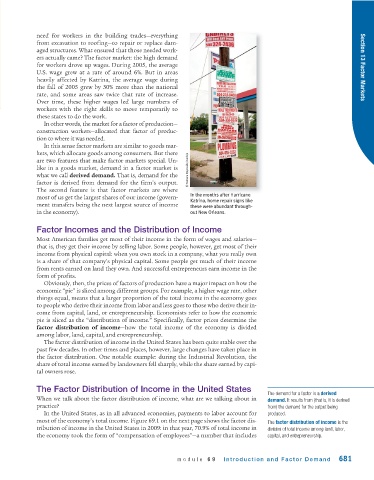Page 723 - Krugmans Economics for AP Text Book_Neat
P. 723
need for workers in the building trades—everything
from excavation to roofing—to repair or replace dam-
aged structures. What ensured that those needed work-
ers actually came? The factor market: the high demand
for workers drove up wages. During 2005, the average Section 13 Factor Markets
U.S. wage grew at a rate of around 6%. But in areas
heavily affected by Katrina, the average wage during
the fall of 2005 grew by 30% more than the national
rate, and some areas saw twice that rate of increase.
Over time, these higher wages led large numbers of
workers with the right skills to move temporarily to
these states to do the work.
In other words, the market for a factor of production—
construction workers—allocated that factor of produc-
tion to where it was needed.
In this sense factor markets are similar to goods mar-
kets, which allocate goods among consumers. But there
are two features that make factor markets special. Un-
like in a goods market, demand in a factor market is © Tamara Reynolds/Corbis
what we call derived demand. That is, demand for the
factor is derived from demand for the firm’s output.
The second feature is that factor markets are where
In the months after Hurricane
most of us get the largest shares of our income (govern-
Katrina, home repair signs like
ment transfers being the next largest source of income these were abundant through-
in the economy). out New Orleans.
Factor Incomes and the Distribution of Income
Most American families get most of their income in the form of wages and salaries—
that is, they get their income by selling labor. Some people, however, get most of their
income from physical capital: when you own stock in a company, what you really own
is a share of that company’s physical capital. Some people get much of their income
from rents earned on land they own. And successful entrepreneurs earn income in the
form of profits.
Obviously, then, the prices of factors of production have a major impact on how the
economic “pie” is sliced among different groups. For example, a higher wage rate, other
things equal, means that a larger proportion of the total income in the economy goes
to people who derive their income from labor and less goes to those who derive their in-
come from capital, land, or entrepreneurship. Economists refer to how the economic
pie is sliced as the “distribution of income.” Specifically, factor prices determine the
factor distribution of income—how the total income of the economy is divided
among labor, land, capital, and entrepreneurship.
The factor distribution of income in the United States has been quite stable over the
past few decades. In other times and places, however, large changes have taken place in
the factor distribution. One notable example: during the Industrial Revolution, the
share of total income earned by landowners fell sharply, while the share earned by capi-
tal owners rose.
The Factor Distribution of Income in the United States
The demand for a factor is a derived
When we talk about the factor distribution of income, what are we talking about in demand. It results from (that is, it is derived
practice? from) the demand for the output being
In the United States, as in all advanced economies, payments to labor account for produced.
most of the economy’s total income. Figure 69.1 on the next page shows the factor dis- The factor distribution of income is the
tribution of income in the United States in 2009: in that year, 70.9% of total income in division of total income among land, labor,
the economy took the form of “compensation of employees”—a number that includes capital, and entrepreneurship.
module 69 Introduction and Factor Demand 681

